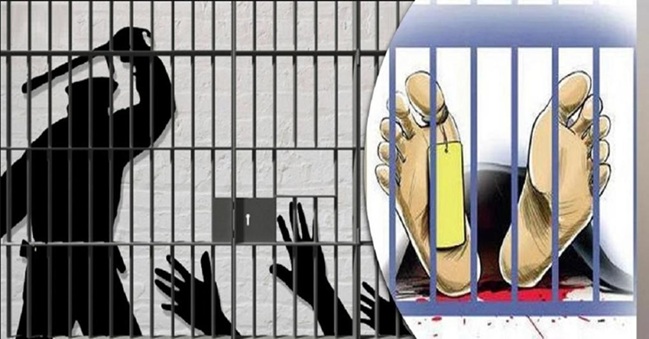Prelims: (Polity + CA)
Mains: (GS 2 – Governance, Constitution) |
Why in the News ?
The Supreme Court has revisited the issue of custodial torture after noting poor compliance with its 2020 directive mandating installation of CCTV cameras in police stations and central investigative agencies. The concern has intensified following 11 custodial deaths in Rajasthan within eight months.
Note: In Paramvir Singh Saini vs. Baljit Singh (2020), the SC ordered CCTV installation in all police stations, later extending it to agencies such as CBI, NIA, ED, NCB, DRI, and others empowered to arrest and interrogate individuals. The Court emphasized that these safeguards are vital to protect the right to dignity and life.

What is Custodial Violence ?
About
- The term is not defined in Indian law, but refers broadly to physical or psychological harm inflicted on persons in police or judicial custody.
- Under the Bharatiya Nagarik Suraksha Sanhita (BNSS), 2023, custody is classified as:
- Police Custody – for interrogation (up to 15 days)
- Judicial Custody – detention in prison till bail or completion of sentence
- Custodial violence includes torture, assault, humiliation, rape, extortion, harassment, and even custodial deaths.
Historical Background of Custodial Violence in India
- Ancient India: Arthashastra prescribed harsh punishments including mutilation and burning.
- Medieval India: Mughal-era Shariat and corporal punishments remained widespread.
- Colonial Period:
- The Police Act, 1861 created a force designed for control and coercion.
- Colonial prisons routinely used beatings, starvation, forced labour, and torture.
- The Prisons Act, 1894 still shapes modern prison administration.
- Post-Independence:
- Legacy policing structures continued with minimal reform.
- Outdated laws, weak oversight, and a coercive policing culture allowed custodial violence to persist.
Data: NHRC recorded 2,346 judicial custody deaths and 160 police custody deaths in 2023–24.
How is Custodial Violence Regulated in India ?
A. Constitutional Provisions
- Article 21: Ensures the right to life, dignity, and freedom from cruel, degrading treatment.
- Article 20(1): Prohibits excessive or retrospective punishment.
- Article 20(3): Protects against self-incrimination and coerced confessions.
B. Statutory Provisions
- Bharatiya Nyaya Sanhita (2023): Criminalises causing hurt or grievous hurt for extracting confessions.
- BNSS (2023): Mandates transparency in arrests and detentions.
- Bharatiya Sakshya Adhiniyam (2023): Invalidates confessions obtained through threats, inducement, or coercion.
C. International Safeguards
- UN Charter (1945): Ensures dignity and rights of detained individuals.
- UDHR (1948): Prohibits torture and inhuman treatment.
- ICCPR (ratified by India in 1979): Protects against torture, cruelty, and arbitrary detention.
- UNCAT: India has signed (1997) but not ratified the convention.
D. Judicial Directives
- DK Basu vs. State of West Bengal (1997): Landmark arrest & detention guidelines; barred third-degree methods; ensured state liability.
- Nambi Narayanan Case (2018): Compensation awarded for humiliation due to wrongful arrest, emphasizing psychological impacts of custodial abuse.
Challenges in Addressing Custodial Violence
1. Weak Legal Framework
- No statutory definition of torture.
- The Prevention of Torture Bill failed to become law.
- Colonial laws like the Police Act, 1861 and Prisons Act, 1894 still govern policing and prisons.
2. Poor Accountability
- BNSS requires government sanction before prosecuting officials.
- Investigations are often delayed; evidence deteriorates; inquiries lack independence.
- Conviction rates remain extremely low.
3. Colonial Policing Culture
- Force-based methods continue due to colonial legacy.
- Third-degree methods normalized within police subculture.
- Political pressure and societal acceptance of “tough policing” reinforce abuse.
4. Capacity Gaps & Corruption
- Limited access to forensic technology and scientific investigation tools.
- Officers rely on physical coercion for quick results.
- Torture is often used for extortion within SHO-dominated hierarchies.
5. Weak Oversight Mechanisms
- NHRC recommendations are advisory and frequently ignored.
- Magisterial inquiries and judicial processes are slow.
- Poor compliance with CCTV installation reduces transparency.
What Measures Can Reduce Custodial Violence ?
1. Define Custodial Violence & Ratify CAT
- Enact a comprehensive anti-torture law defining custodial violence.
- Ratify UNCAT, establishing binding anti-torture obligations.
- Create strong accountability and reporting mechanisms.
2. Use Technology for Transparency
- Nationwide implementation of CCTV in police stations.
- Digital arrest records and integrated reporting on CCTNS.
- Video-recorded questioning to prevent coercion.
3. Build Professional Capacity
- Training in:
- Non-coercive interrogation
- Forensic tools
- Human rights sensitivity
- Ethical policing
- Invest in modern investigative infrastructure.
4. Strengthen Human Rights Institutions
- Give NHRC binding authority.
- Ensure mandatory reporting of custodial deaths within 24 hours.
- Penalise non-compliance by police units.
5. Expand Public Awareness
- Increase citizen awareness about arrest rights.
- Use civil society, media, and legal literacy campaigns to discourage acceptance of violent policing.
FAQs
1. What is custodial violence ?
Custodial violence refers to physical, psychological, or sexual harm inflicted on individuals in police or judicial custody, including torture, harassment, extortion, and custodial deaths.
2. Which constitutional provisions safeguard individuals from custodial torture?
- Article 21: Right to life and dignity
- Article 20(3): Protection against self-incrimination
- Article 20(1): Protection against retroactive punishment
3. What was the significance of the Supreme Court’s 2020 judgment on CCTV cameras ?
In Paramvir Singh Saini vs. Baljit Singh (2020), the SC mandated CCTV cameras in all police stations and extended this to central agencies like CBI, ED, NIA, NCB, DRI to deter torture and increase transparency.
4. What are the main causes behind custodial violence in India ?
Key reasons include outdated colonial laws, weak accountability mechanisms, coercive policing culture, lack of forensic capacity, and poor compliance with oversight directives.
5. Has India ratified the UN Convention Against Torture (UNCAT) ?
No. India signed UNCAT in 1997 but has not ratified it, meaning it is not legally bound by international anti-torture obligations
|



